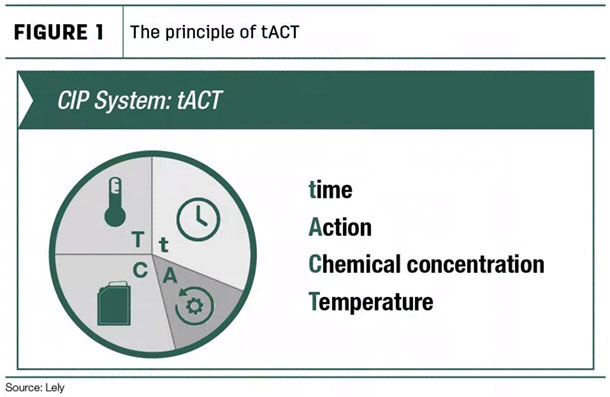Certainly, with pressure on profit margin more pronounced than ever, it is vital to ensure poor hygiene is not influencing your bottom line.
Hygiene is extremely important in the production of high-quality milk, which makes cleaning milk contact surfaces, the exterior of the robot and the environment essential. When the outside is clean, the risk of contamination on the inside lessens. Properly cleaning and sanitizing your milking equipment cannot be underestimated, as it is the cleanliness and daily function that directly affects the quality and salability of the final product. Even though it may be tempting to sometimes put off scheduled maintenance, doing so can cost more in the end.
When cleaning an automated milking system, the goal is to physically and chemically break down milk soils into solution and drain them from the system. Here are some methods recommended by our team members.

- Several factors influence this process. These include the principles of tACT: time, action, chemical concentration and temperature. The four factors indicate the effectiveness of cleaning: Time stands for the cleaning cycle time for the cleaning solution; action for the flow rate of the cleaning solution; chemical for the type and strength of the detergent, acid and sanitizer; and temperature for the temperature of the cleaning solution.
—Kira Anderson, aftermarket sales specialist
- The wash system needs to remove the organic soils, like fats and proteins, and the inorganic soils, such as the minerals. To reduce the amount of time needed to do this, we focus closely on the other three factors. We need to start with a proper pre-rinse wash cycle to remove as much of the milk residue as possible. Continuation of the cleaning cycle includes the chemical factor. An alkaline detergent with high temperatures will remove the organic soils.
The alkaline detergent emulsifies fats by saponification (or soap-making) and breaks up the proteins by cleaving peptide bonds that hold the proteins together. Acids can be used to aid in the removal of inorganic soils like milk-stone or minerals on milking equipment surfaces. The last and final cycle of the clean-in-place (CIP) process is the sanitize cycle. To aid in the effectiveness of these chemicals and reduce time needed for the wash cycle, temperature is used to accelerate the speed with which these soils can be removed from the entire system.
—Gaylen Guyer, aftermarket field specialist
- Safety first. When monitoring a wash or diagnosing a problem, always wear your personal protective equipment (PPE). The chemicals used for cleaning are concentrated and can be very dangerous. Always wear gloves and goggles, and use common sense when handling these products. Make sure all products are in proper containers, are labeled correctly, and never mix chemicals together (unless recommended by the manufacturer).
—Kaden Schvaneveldt, aftermarket field specialist
- Do not be intimidated. The fundamentals of CIP are similar in a robot as it is in a conventional parlor. Each involve cleaning the same components of milk (fats, proteins, minerals, sugars and bacteria). It all comes down to time, action, concentration and temperature. As with most things, following the fundamentals will get you much closer to great results. Careful monitoring and documentation will support long-term reliable results when part of a complete maintenance and support program.
—Paul Peetz, milking technologies manager

-
Steve Kraft
- Aftermarket Field Support Manager
- Lely North America






